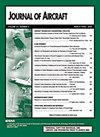On the Dynamic Behavior of Wings Incorporating Floating Wingtip Fuel Tanks
IF 2.1
3区 工程技术
Q2 ENGINEERING, AEROSPACE
引用次数: 0
Abstract
Recent studies have shown that semi-aeroelastic hinge devices can enable larger aircraft wingspans. Such a device would be folded on the ground to meet airport width restrictions, locked during cruise for optimal aerodynamic performance, and released during maneuvers to alleviate flight loads. In contrast, this paper uses a wind tunnel experiment to study the aeroelastic behavior of floating wingtip fuel tanks. This device consists of a freely floating wingtip with an additional mass attached in the form of a liquid-filled fuel tank. The static aeroelastic results show that altering the fuel tank’s filling level and position allows the wingtip to float at an optimal angle for aerodynamic efficiency across various angles of attack and fuel masses. Additionally, this paper shows that, with careful selection of the mass distribution of the wingtip, dynamic load alleviation comparable to the semi-aeroelastic hinge concept can be achieved during turbulence and one-minus-cosine encounters. Furthermore, the effect of fluid motion is shown to reduce incremental loads during random turbulence encounters by up to 10%; however, it has a negligible impact on the response to one-minus-cosine encounters. Such results are also confirmed by a numerical model incorporating a simple reduced-order fluid sloshing model.带浮动翼尖燃料箱的机翼动力学特性研究
最近的研究表明,半气动弹性铰链装置可以实现更大的飞机翼展。这样的装置将在地面上折叠以满足机场宽度的限制,在巡航时锁定以获得最佳的空气动力学性能,在机动时释放以减轻飞行负荷。与此相反,本文采用风洞试验研究了浮动翼尖油箱的气动弹性特性。这个装置由一个自由浮动的翼尖和一个附加的质量组成,附加的形式是一个充满液体的燃料箱。静态气动弹性试验结果表明,改变油箱的填充水平和位置可以使翼尖在不同迎角和燃料质量下以最佳的气动效率漂浮。此外,本文还表明,通过仔细选择翼尖的质量分布,可以在湍流和1 -余弦碰撞期间实现与半气动弹性铰链概念相当的动载荷缓解。此外,流体运动的影响被证明可以减少随机湍流遇到时的增量载荷高达10%;然而,它对1 -cos遭遇的响应的影响可以忽略不计。结合简化阶流体晃动模型的数值模型也证实了上述结果。
本文章由计算机程序翻译,如有差异,请以英文原文为准。
求助全文
约1分钟内获得全文
求助全文
来源期刊

Journal of Aircraft
工程技术-工程:宇航
CiteScore
4.50
自引率
31.80%
发文量
141
审稿时长
6 months
期刊介绍:
This Journal is devoted to the advancement of the applied science and technology of airborne flight through the dissemination of original archival papers describing significant advances in aircraft, the operation of aircraft, and applications of aircraft technology to other fields. The Journal publishes qualified papers on aircraft systems, air transportation, air traffic management, and multidisciplinary design optimization of aircraft, flight mechanics, flight and ground testing, applied computational fluid dynamics, flight safety, weather and noise hazards, human factors, airport design, airline operations, application of computers to aircraft including artificial intelligence/expert systems, production methods, engineering economic analyses, affordability, reliability, maintainability, and logistics support, integration of propulsion and control systems into aircraft design and operations, aircraft aerodynamics (including unsteady aerodynamics), structural design/dynamics , aeroelasticity, and aeroacoustics. It publishes papers on general aviation, military and civilian aircraft, UAV, STOL and V/STOL, subsonic, supersonic, transonic, and hypersonic aircraft. Papers are sought which comprehensively survey results of recent technical work with emphasis on aircraft technology application.
 求助内容:
求助内容: 应助结果提醒方式:
应助结果提醒方式:


